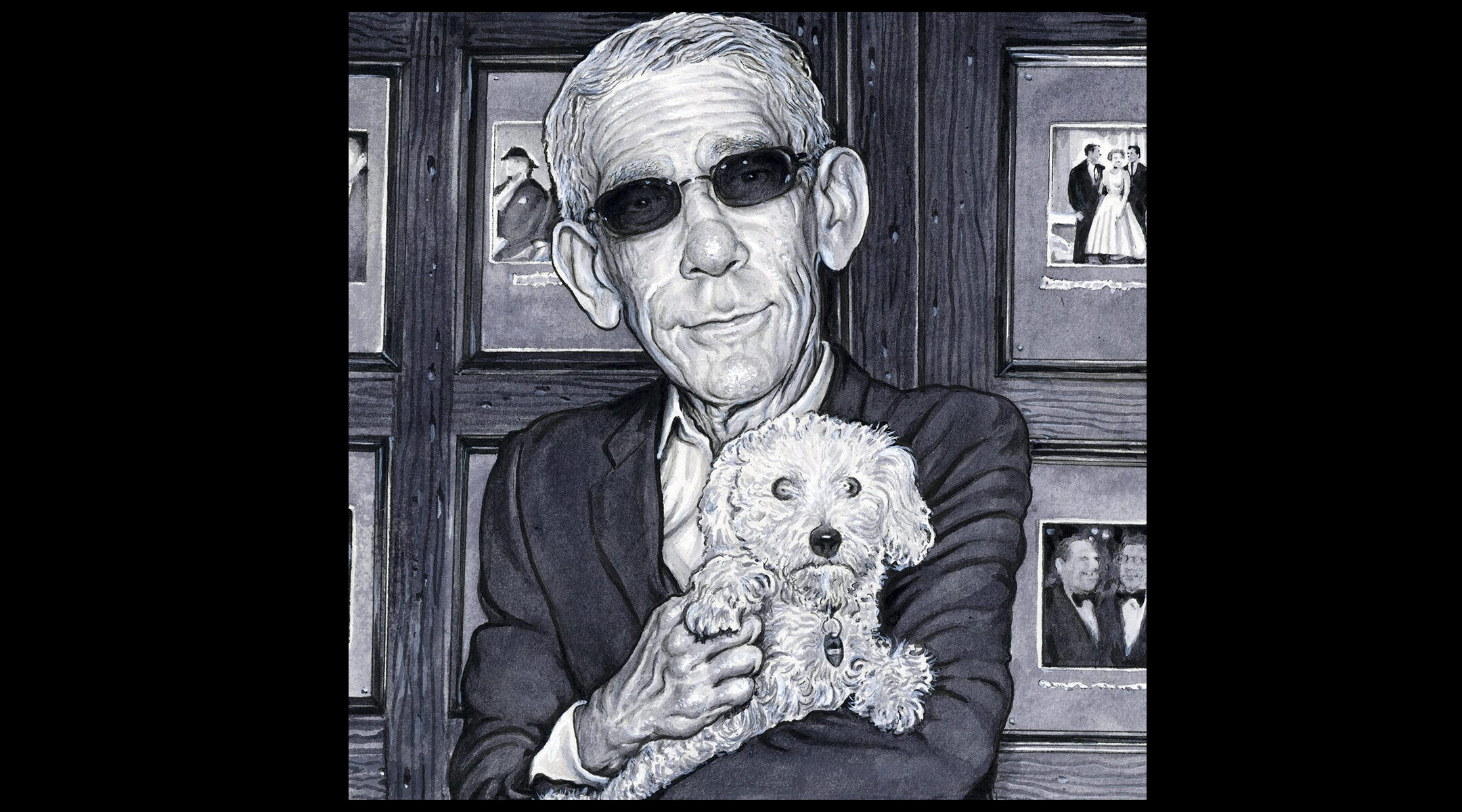(JTA) — Ever hear Bob Dylan’s “Like a Rolling Stone” sung in Yiddish dialect? It used to be a regular bit performed by comedian and actor Richard Belzer, who died this week at 78. He also used to do a routine about Bob Dylan’s bar mitzvah in which he recited a Hebrew prayer in the singer’s distinctive tone. A similar Elvis bar mitzvah bit was also part of his routine.
Surprisingly, Belzer performed these niche routines in numerous comedy venues and even on the nationally televised “The Late Show with David Letterman.” In addition to a variety of other Jewish references embedded in his act, Belzer also performed Yiddish-inflected parodies of Prince’s “Let’s Go Crazy” and “When Doves Cry.”
But like so many American comedians of the Hebraic persuasion, Belzer didn’t really work Jewish. The bulk of his act was general and observational. To be sure, there were bits and pieces of Jewish material that can be found scattered about his comedic oeuvre, though to have the broad appeal he achieved, he understood that he had to deal in comic generalities. But to have thrown bits like Dylan’s bar mitzvah into routines for venues as broad as Letterman is an indication that he was truly dedicated to his Jewish material.
Moreover, he enjoyed it. Around 2003, after he’d snagged a contract to do a special on a cable network, he approached Letterman’s legendary bandleader, Paul Shaffer, and told him he wanted to do something “Jewish” for the show. Shaffer suggested The Barton Brothers’ risqué Yiddish radio ad parody song “Joe and Paul.” Belzer loved the idea. The duo learned the Yiddish lines and performed the tune, which, in veiled Yiddish tones, talks about masturbation and going to a prostitute named “Cock-eyed Jenny.” It was so well-received and the two enjoyed it so much, they began to do it in other venues. It eventually wound up on a 2008 album titled “The Jewish Songbook,” together with songs sung by Neil Sedaka and Barbra Streisand.
Which is why it’s been strange to read obit after obit in outlets like The New York Times, The Guardian and The Hollywood Reporter, among others, that didn’t bother to mention that Belzer was Jewish — even when, as the Jewish Telegraphic Agency pointed out, the character for which he was best known, Det. John Munch on “Homicide: Life on the Street” and “Law & Order: Special Victims Unit,” identified as Jewish. Obituaries, after all, are meant to be the final stock-taking of a person’s life. They should include the basics of who they were. And one of the basics of Richard Belzer is that he was a Yid.
Moreover, according to Paul Shaffer, he was a proud one. I should also point out that I don’t mean Jewish in a religious sense. Belzer, after all, appears to have been an atheist, so what is meant here is Jew as an ethnic category, one that apparently confounds a lot of people and which results in many Jewish artists being described as anything but Jewish.
To call Burt Bacharach an “American composer” or Barbara Walters a “pioneering woman newscaster” is accurate, but misses a significant ethno-cultural aspect of these people, one that was integrally responsible for making them who they are and influencing their creative choices. The notion that “Jewish” is something more than a religious denomination — that it’s a wide-ranging culture that includes art, literature, music, food, folkways and languages — is terribly difficult to grasp for some people.
One case in point is an excellent book by Kliph Nesteroff that appeared in 2015 called “The Comedians,” which richly details the history of stand-up comedy in America. Assiduously researched, it’s become the definitive work on the topic. The book, however, deracinates the history of the field. From reading it, you would never know that 20th-century American comedy was largely a Jewish enterprise. In fact, you’d hardly know that Jews were involved at all. You will read about comedians such as Milton Berle, Joan Rivers, Lenny Bruce and Jerry Seinfeld, but you’ll have no idea that any of them are Jews, or that Jewish history and culture might have had at least a nominal influence in their work and in their field. It’s like a history of opera that doesn’t bother to mention Italians: They weren’t the only ones involved, but the field would have been far poorer without their distinct contributions.
The matter of the mysteriously disappearing Jew occurs in other industries as well. It’s particularly egregious in the art world and popped up last year at the opening of the Academy Museum of Motion Pictures, a lavishly funded new institution that celebrated the diversity of Hollywood, touting the contributions of minorities involved in the film industry. However, the one minority they initially left out was the one that was instrumental in building that very industry. It’s all part of a phenomenon comedian David Baddiel describes as “Jews don’t count.” They’re not considered a minority among the many others and have apparently become white people who don’t believe in Jesus. As such, they’re not worthy of distinction.
History, however, tells a different story. When Jews began to come to this country en masse at the end of the 19th century, the culture they met often mocked and derided them. Suffering discrimination in multiple realms, they were excluded from certain neighborhoods, clubs and a variety of occupations. Universities placed quotas on them. Many hotels denied them entry, a fact that led to the creation of hundreds of Jewish hotels in New York’s Catskill Mountains. While American attitudes toward Jews eventually changed, a fact that allowed them to become full participants in society, they still find themselves victimized by Jew-hatred. Even though it’s often denied, the mystery of Jewish difference, apparently, is still a thing.
And for Richard Belzer, it was a thing he obviously enjoyed. Comedy writer and novelist Seth Greenland, who worked on numerous projects with Belzer and whose first novel was based on him, told me, “Something about Richard was quintessentially Jewish. He was kind, disputatious, intellectually curious, and hilarious. Although he wasn’t at all religious, he was proud to be Jewish and embraced that identity.”
Alan Zweibel, a comedy writer who worked with Belzer beginning in the mid-1970s on “Saturday Night Live,” added, “Belz made no bones about being Jewish in his act or in his life.” Zweibel once took Belzer to his parents’ Long Island home for a Friday night dinner, over which the comedian bonded with Mr. and Mrs. Zweibel over milchig and fleishig issues, the minutiae of keeping kosher. Alan’s father pointed to Belzer and told his son, “You could learn a lot from this guy.”
“Belz and Gilbert Gottfried would always do Jewish shtick and saw themselves in a long line of Jewish comics,” said author Ratso Sloman. “And one time I was at Catch [A Rising Star], probably in the mid ’80s and at the end of the night, Belz and Gilbert went on stage and did dueling old Jewish weather forecasters. It was so hilarious, I almost pissed my pants.”
Paul Shaffer also recalled how Belzer once accompanied him to say Kaddish for Shaffer’s father at the Carlebach Shul on the Upper West Side. “I didn’t know what kind of Jewish education he had,” Shaffer told me, “but the cat could daven [pray].” Paul added that he and Belzer once bonded over old cassettes of Friars Club roasts. One of the tapes was of a roast emceed by DJ and Sinatra expert William B. Williams (born Velvel Breitbard), who, whenever someone’s joke bombed, would begin to utter the Jewish prayer for the dead — “Yisgadal, veyiskadash, shemey rabo….” — and get big laughs. Belzer loved it so much, he stole it and would recite the prayer onstage at subsequent roasts whenever a comic bombed, and even when his own jokes died.
Yisgadal, yisgadash, Belz. You will be missed.
JTA has documented Jewish history in real-time for over a century. Keep our journalism strong by joining us in supporting independent, award-winning reporting.







